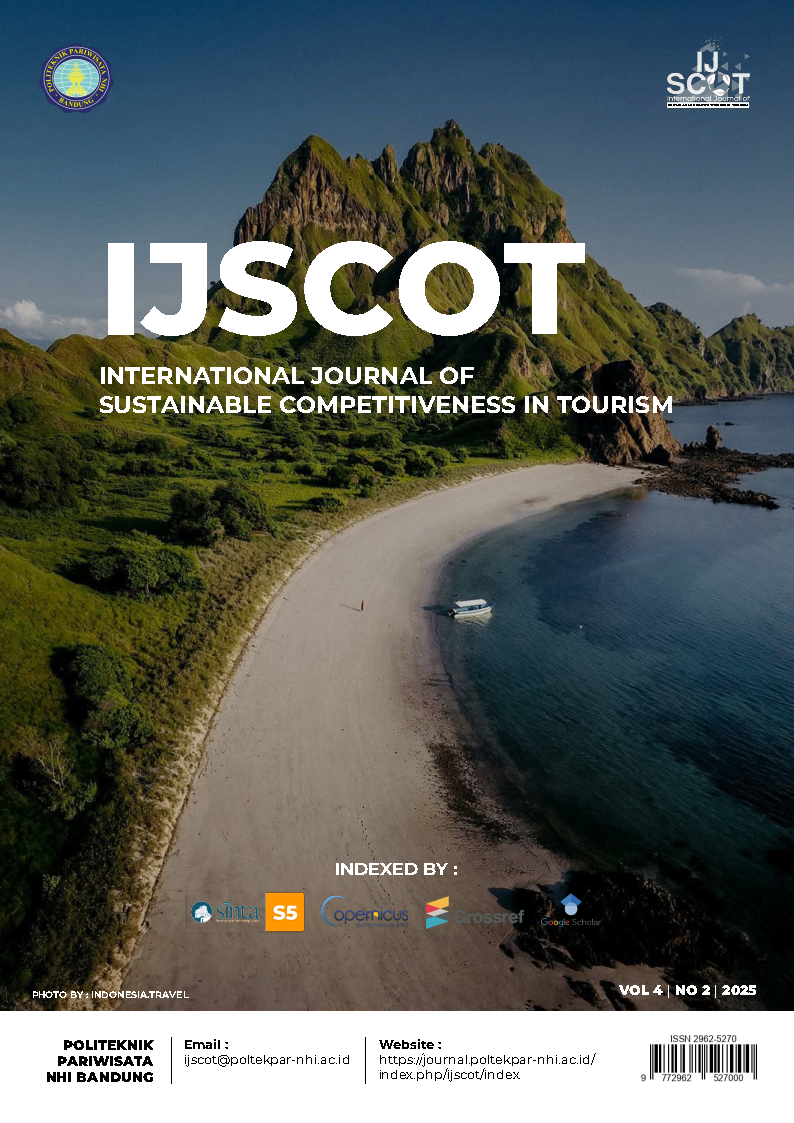Analysis Potential and Strategies For The Development Of Ecotourism in Wanagiri Village, Tabanan Regency
Abstract
Post-pandemic shifts in tourist travel patterns have led to the emergence of a new trend commonly referred to as NEWA (Nature, Eco-tourism, Wellness tourism, and Adventure tourism). By emphasizing nature-based tourism concepts, this trend presents a significant opportunity for Wanagiri Village, located in Tabanan Regency, to advance its potential as a village grounded in eco-tourism principles. This study seeks to analyze the tourism potential of Wanagiri Village and to formulate alternative strategic recommendations for the village’s tourism managers in the development of eco-tourism. A mixed-methods approach was adopted, integrating qualitative and quantitative analyses, specifically employing SWOT and AHP frameworks to comprehensively address each research question. Data collection was conducted through surveys, interviews, observations, literature reviews, and documentation. Informants were selected using purposive sampling techniques, resulting in a total of ten key informants. The findings indicate that Wanagiri Village possesses substantial potential for development as an eco-tourism-based tourist village, particularly in promoting education and conservation principles aligned with sustainable tourism paradigms. Based on the IFAS-EFAS analysis, the strategic position of Wanagiri Village falls within Quadrant I, which enables tourism managers to pursue aggressive strategies for eco-tourism product development. Furthermore, the AHP (Analytical Hierarchy Process) analysis identified priority strategies for implementation, which include: 1) Developing professional local human resources to enhance the quality and sustainability of eco-tourism activities. 2) Designing eco-tourism packages that integrate visits to the village’s natural attractions. 3) Undertaking promotional activities through social media platforms and the establishment of a dedicated website. 4) Establishing collaborations with foreign investors as tourism business operators, aiming to strengthen the eco-tourism brand and develop bundled eco-tourism products unique to the village.
References
Avinda, C. B., Sudiarta, I. N., & Unud, F. P. (2016). STRATEGI PROMOSI BANYUWANGI SEBAGAI DESTINASI WISATA ( STUDI KASUS PADA DINAS KEBUDAYAAN DAN PARIWISATA ). 4(1), 55–60.
Bayu Wisnawa, I. M., Telagawathi, N. luh W. S., Rusmiati, N. N., Wartana, I. M. H., & Budiasa, I. K. (2023). Pengembangan Potensi Wisata dengan Pendekatan Sapta Pesona di Desa Wanagiri Kauh Tabanan Bali. Jurnal Manajemen Perhotelan Dan Pariwisata, 6(1), 250–256. https://doi.org/10.23887/jmpp.v6i1.57809
Freire, J. R. (2016). Managing destination brand architecture - The case of Cascais Municipality. Place Branding and Public Diplomacy, 12(1), 78–90. https://doi.org/10.1057/pb.2015.23
Hanum, F., Dienaputra, R. D., Suganda, D., & Muljana, B. (2021). Strategi Pengembangan Potensi Ekowisata di Desa Malatisuka. Jurnal Master Pariwisata (JUMPA), 8, 22. https://doi.org/10.24843/jumpa.2021.v08.i01.p02
I Gede Made Sukariyanto, I. M. G. D. S. (2023). Science in Tourism Destination Kabupaten Tabanan I Gede Made Sukariyanto 1 , I Made Gede Darma Susila 2. Journal of Applied Science in Tourism Destination, 1(1). https://doi.org/10.52352/jastd.v1i1.1069
Mustafa, I. Y., & Khalim, A. (2023). Analisis Differensiasi Produk Kuliner Lokal Dalam Mendukung Wisata Kota Cirebon. Jurnal Inovasi Penelitian, 4(3), 573. https://stp-mataram.e-journal.id/JIP/article/view/2747
Nasional, U. P. (2021). PENGEMBANGAN WISATA KAMPUNG JALAK BALI DI DESA BONGAN DENGAN PEMANFAATAN MEDIA SOSIAL. 7(1), 95–104.
Nisak, Z. (2004). Analisis Swot Untuk Menentukan Strategi Kompetitif. Jurnal Ekonomi Bisnis, 1–8.
Pajriah, S. (2018). Peran Sumber Daya Manusia Dalam Pengembangan Pariwisata Budaya Di Kabupaten Ciamis. Jurnal Artefak, 5(1), 25. https://doi.org/10.25157/ja.v5i1.1913
Porter, M. (2012). Teori Michael E. Porter.
Pujiningrum Palimbunga, I. (2018). Keterlibatan Masyarakat Dalam Pengembangan Pariwisata Di Desa Wisata Tabalansu, Papua. Jurnal Master Pariwisata (JUMPA), 05, 193. https://doi.org/10.24843/jumpa.2018.v05.i01.p10
Purwahita, A. A. A. R. M., Bagus, P., Wardhana, W., & Ardiasa, I. K. (2021). DAMPAK COVID-19 TERHADAP PARIWISATA BALI DITINJAU DARI SEKTOR SOSIAL , EKONOMI , DAN ( SUATU TINJAUAN PUSTAKA ). 1(2).
Saaty, T., Vargas, L., & St, C. (2022). The Analytic Hierarchy Process.
Sarmoko, S., Novianti, E., & Rizal, E. (2023). Penguatan Destination Branding Untuk Menarik Investor Dalam Pengembangan Pariwisata Danau Toba. Jurnal Inovasi Penelitian, 4(3), 735–754. https://stp-mataram.e-journal.id/JIP/article/view/2768%0Ahttps://stp-mataram.e-journal.id/JIP/article/download/2768/2199
Spradley, L. (2018). Analisis Data Kualitatif Model Spradley. March, 0–9.
Sugiyono. (2019). Metode penelitian kuantitatif kualitatif dan R&D / Sugiyono (01 ed.). Alfabeta.
Vargas, L. (2022). The Analytic Hierarchy Process (Issue July).
Vargas, R. V. (2016). Using the Analytic Hierarchy Process ( AHP ) to Select and Prioritize Projects in a ( AHP ) TO SELECT AND PRIORITIZE PROJECTS IN A PORTFOLIO. January 2010.
Warouw, D. M. D., & Rembang, M. (n.d.). PENTINGNYA WEBSITE SEBAGAI MEDIA INFORMASI PARIWISATA KABUPATEN MINAHASA. 1–17.
Authors

This work is licensed under a Creative Commons Attribution-ShareAlike 4.0 International License.

